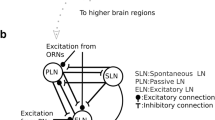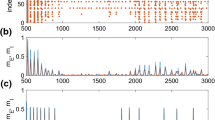Abstract
Recent studies in honeybees have demonstrated that, when odor-evoked action potentials in antennal lobe neurons are pharmacologically desynchronized, the bees are impaired in their ability to discriminate chemically similar odor stimuli. Using a reduced computational model of the honeybee antennal lobe, we show how changes in spike-synchronization properties alone, independent of changes in overall spike-discharge rate or differences in activity levels among responsive neurons, can produce changes in associative learning similar to those observed experimentally.
Similar content being viewed by others
References
Av-Ron E, Vibert JF (1996) A model for temporal and intensity coding in insect olfaction by a network of inhibitory neurons. Biosystems 39:241-250.
Faber T, Joerges J, Menzel R (1999) Associative learning modifies neural representations of odors in the insect brain. Nat. Neurosci. 2:74-78.
Hammer M (1993) An identified neuron mediates the unconditioned stimulus in associative olfactory learning in honeybees. Nature 366:59-63.
Kerszberg M, Masson C (1995) Signal-induced selection among spontaneous oscillatory patterns in a model of honeybee olfactory glomeruli. Biol. Cybern. 72:487-495.
Laurent G (1999) A systems perspective on early olfactory coding. Science 286:723-728.
Laurent G, Davidowitz H (1994) Encoding of olfactory information with oscillating neural assemblies. Science 265:1872-1875.
Linster C, Smith BH (1997) A computational model of the response of honeybee antennal lobe circuitry to odor mixtures: Overshadowing, blocking and unblocking can arise from lateral inhibition. Behav. Brain Res. 87:1-14.
MacLeod K, Bäcker A, Laurent G (1998) Who reads temporal information contained across synchronized and oscillatory spike trains? Nature 395:693-698.
MacLeod K, Laurent G (1996) Distinct mechanisms for synchronization and temporal patterning of odor-encoding neural assemblies. Science 274:976-979.
Smith BH (1991) The olfactory memory of the honeybee Apis mellifera. I. Odorant modulation of short-and intermediate-term memory after single-trial conditioning. J. Exp. Biol. 161:367-382.
Stopfer M, Bhagavan S, Smith BH, Laurent G (1997) Impaired odour discrimination on desynchronization of odour-encoding neural assemblies. Nature 390:70-74.
Sun XJ, Fonta C, Masson C (1993) Odour quality processing by bee antennal lobe interneurones. Chem. Sens. 18:355-377.
Teyke T, Gelperin A (1999) Olfactory oscillations augment odor discrimination not odor identification by Limax CNS. Neuroreport 10:1061-1068.
Wehr M, Laurent G. (1996) Odour encoding by temporal sequences of firing in oscillating neural assemblies. Nature 384:162-166.
Author information
Authors and Affiliations
Rights and permissions
About this article
Cite this article
Linster, C., Cleland, T.A. How Spike Synchronization Among Olfactory Neurons Can Contribute to Sensory Discrimination. J Comput Neurosci 10, 187–193 (2001). https://doi.org/10.1023/A:1011221131212
Issue Date:
DOI: https://doi.org/10.1023/A:1011221131212




